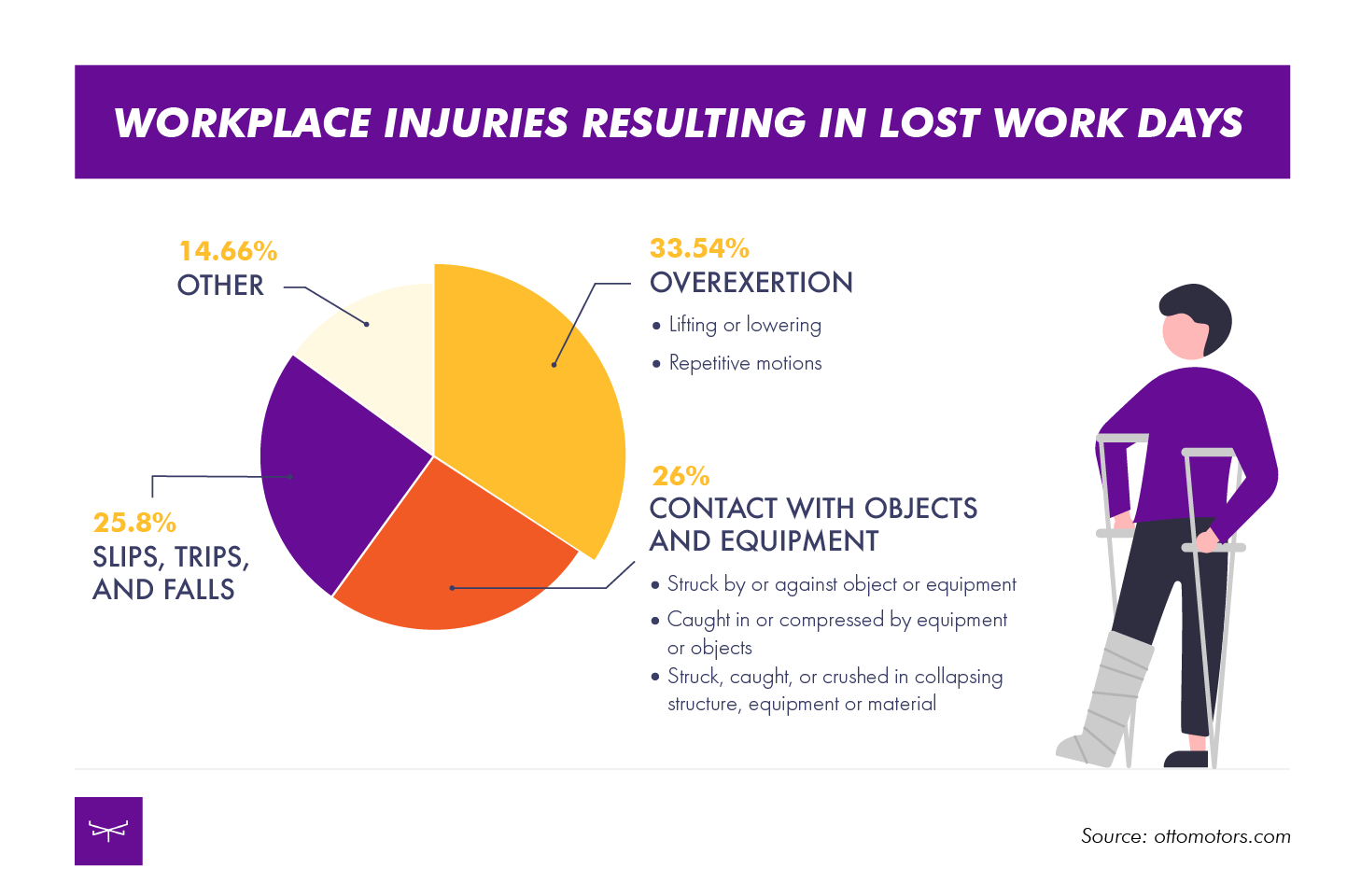4 Reasons Why Mobile Robots Are the Solution to Operational Safety
Workplace safety is a major concern for many businesses in high-risk industries like manufacturing, warehousing, and transportation, especially with the recent impacts of the COVID-19 pandemic. In fact, according to 72% of manufacturers, collisions and other shop floor accidents are a big challenge for their businesses — especially with human error being the number one cause of fulfilment issues.
The most recent data from the Bureau of Labor Statistics (BLS) show that 2019 saw 5,333 fatal occupational injuries recorded in the US alone — a 3.6% increase compared to 2017 and the largest annual number since 2007. Out of these, 2,122 were transportation incidents — 2% more than in 2018 — which evidently makes the transportation sector account for the largest number of fatalities.
If you would like to use this data on your website, contact us via email.
In terms of financial consequences, workplace injuries cost the US roughly €850K per week — that is around €44.3B to €51.1B per year. In the UK, on the other hand, an average of 82K employees was injured on a yearly basis between 2016/17 and 2018/19. Keeping in mind that the UK has a workforce of merely 33 million, this number is extremely high. Moreover, considering productivity losses and the like, this costs the UK roughly €2M per fatal injury and €10K per non-fatal injury.
In 2018, the European Union saw 1.77 fatal accidents per 100K persons employed. This number ranged from less than 1.00 in Finland, Greece, Germany, and the Netherlands, to over 3.00 in Croatia, Lithuania, Bulgaria, and Latvia. Luxembourg and Romania, however, topped the list, with a number of 4.22 and 4.33 respectively. On the other hand, there were 1,659 non-fatal accidents per 100K persons employed across the European Member States.
If you would like to use this map on your website, contact us via email.
How Are Mobile Robots Improving Operational Safety?
It is no news that workplace safety and productivity are closely linked. Manual material handling equipment can be a huge risk for businesses due to the fast-paced nature of the environment in which vehicles are operating — leading to frequent accidents and collisions. Moreover, the high risk of aggressive and inexperienced driving makes warehouse safety one of the main concerns in industrial spaces.
If you would like to use this bar chart on your website, contact us via email.
For example, since its acquisition of Kiva Systems for €661.31 back in 2012, Amazon has increasingly deployed robots in their warehouses. This made workers’ tasks more repetitive, and workers were now isolated at a workstation. On top of that, due to the work speed of the robots, productivity expectations for workers were almost doubled. It was therefore not really a surprise that from 2016 to 2019, the average injury rate was 50% higher in Amazon’s robotic warehouses.
According to a May 2019 report, ergonomic issues such as excessive repetition and bending down led to 74% of injuries among Amazon’s employees in robotic warehouses in 2018. Moreover, another report from November 2019 showed that the implementation of job rotation — which, along with taking extra breaks, is recommended by the federal agency — had driven down injury rates at Amazon’s robotic warehouses.
Many safety issues that arise when traditional robots are used — such as manually operated forklifts — can be solved by deploying mobile robots. With autonomous mobile robots (AMRs) being a large part of the safety regulations across many industries, a number of ways in which AMRs are improving operational safety can be distinguished:
Improved Visibility Prevents Collisions
A frequent cause of workplace injuries is limited or obstructed visibility. Built-in sensors, LiDAR scanners, mapping, and universal fleet management ensure that AMRs can detect and respond to people and objects in their path, which reduces the risk of injuries and accidents due to transportation substantially.
If you would like to use this bar chart on your website, contact us via email.
One of the main benefits of AMRs and collaborative robots (cobots) is their ability to improve workplace safety in highly dynamic environments. Whether you are using AMRs, automated guided vehicles (AGVs), visually guided vehicles (VGVs), or any other type of robot, the risk of workplace injury can be significantly reduced.
Unlike most older technologies, AMRs are able to autonomously navigate around obstacles and people on their path while setting up the best route to get to their destination, thereby removing humans from dynamic, high-risk environments. In other words, these types of cobots are — in many cases — a great way to optimise workplace safety and simultaneously improve productivity.
A forklift operated by a human driver is controlled by quick decision making that may be impeded by human error, whereas AMRs are specifically programmed to minimise human error — thereby helping businesses to become more sustainable. AMRs also scan their surroundings well in advance, making it possible for them to easily change their route or make a safety stop to avoid collisions with people, other robots, or objects. Even though forklifts will remain necessary for many operations, safety can still be improved by adding AMRs to the work floor.
Limited Contact With Dangerous Machinery
Manually-operated forklifts are the most commonly used technology in warehousing and material handling. However, they are also one of the most dangerous technologies being used these days. Evidently, a common challenge in the warehousing and storage industry is the safety of forklifts.
According to the Occupational Safety and Health Act (OSHA), there are approximately 97K forklift injuries on a yearly basis. Amongst these, OSHA estimates around 85 fatal accidents per year, 34.9K serious injuries, and 61.8K non-serious injuries.
If you would like to use this pie chart on your website, contact us via email.
Considering the fact that there are roughly 855.9K forklifts in the US alone, this would mean that each year, more than 11% of all forklifts will be involved in some type of accident — assuming there will be only one accident per forklift. In fact, during their average 8-year lifespan, there is a 90% chance of a forklift causing a serious accident.
Even more so, in 2017, the BLS reported injury and illness cases amongst 5% of all full-time workers for the warehousing and storage industry. Not only do these factors pose a risk to the health of employees, but they also negatively impact productivity levels. The following table illustrates the main causes of forklift accidents and where they occur:
| Fatal accident type | % | Where fatalities occur | % |
|---|---|---|---|
| Crushed by vehicle tipping over | 42% | Mining | 1.2% |
| Crushed between vehicle and a surface | 25% | Construction | 23.8% |
| Crushed between two vehicles | 11% | Manufacturing | 42.5% |
| Struck or run over by a forklift | 10% | Transportation | 11% |
| Struck by falling material | 8% | Wholesale trades | 12.5% |
| Fall from platform on the forks | 4% | Retail trade | 9% |
Forklift accidents happen all the time, but studies show that many of these could have been prevented had the driver been properly trained. It is crucial to keep the load as low as possible to avoid tip-over accidents. Interestingly, 42% of forklift accidents are caused by the driver trying to jump off a tipping vehicle, while, in fact, staying with the vehicle if it tips over is one of the main safety measures.
With a worker getting injured on the job every seven seconds and a loss of 104 million production days due to work-related injuries in 2017, using mobile robots as an alternative will not only lower the risk of injury and death among workers substantially, but it will also keep your business moving without losing valuable production time.
Automation of Repetitive Tasks
By taking on repetitive, high-risk tasks, AMRs will be able to reduce the risks of collisions while simultaneously optimising operational efficiency. Moreover, one of the main injury causes in warehouses is related to the repetitive nature of the work. In fact, lifting or lowering objects repetitively accounts for more than 33% of worker injuries in manual material handling.
Workers are moving and lifting objects every day, which can lead to mistakes that result in harm to both humans and products. “If a job is repetitive and boring, human workers tend to make a mistake, whereas robots can do these things the same way time after time”, explains Frank Hearl from the National Institute for Occupational Safety and Health (NIOSH).
Besides, the different forms of warehouse automation — especially mobile robots — allow workers to focus on more complex and rewarding tasks instead. Considering the fact that 19% of unplanned downtime in the industry is a direct result of human error, autonomy is nearly invaluable.
Easy Adoption of Social Distancing Measures
Even though safety has been a major concern for the manufacturing industry for many years, it has definitely been heightened due to the COVID-19 pandemic. Various protective measures have been put in place to lower the risk of spreading the virus within workplaces. However, these do not always turn out to be effective.
Ever since the COVID-19 crisis started, social distancing measures have required a reduction in direct human contact. In order to keep their operations up and running, manufacturers have been trying to adapt to the mandatory guidelines. With manufacturing work usually requiring close contact with workers, this has not been an easy task. However, AMRs are able to eliminate unnecessary contact between workers, thereby avoiding shutdowns.
It is definitely no surprise that the pandemic has increased the interest in and adoption of mobile robots. According to the Robotic Industries Association (RIA), “Autonomous deliveries are bringing supplies to people as they adopt social distancing. Automated workstations are speeding up the work of pharmaceutical companies. Automation is on the front lines of this battle”.
Moreover, studies show that the pandemic is highly impacting organisations’ supply chains, with 95% of organisations predicting that they will be or already have been impacted by disruptions in their supply chain as a result of the COVID-19 crisis. One way to limit the impact of the pandemic is to adopt mobile robots as a means to optimise social distancing measures and the overall safety of the workplace.
The kinds of risks and accidents discussed above can impact the workplace on many different levels, causing a decrease in productivity, absenteeism due to long-and short term employee injuries and even death, higher liability and insurance costs, product damage, and so on. So how can we avoid this from happening? How do we optimise the safety on our work floor?
Not only is adopting AMRs the answer to these questions, but they will also help your business improve its operations in other ways: over 70% of warehouses and order fulfilment centres that have deployed AMRs have seen double-digit improvements. Turns out that optimising the company’s overall efficiency and productivity was their main reason for adopting mobile robotics in the first place. However, as we have seen with the case of Amazon, it is crucial for companies to align workers’ tasks with the abilities of the robots in order to avoid unnecessary injuries.
About Meili Robots
Meili Robots is developing the next-generation of mobile robots fleet management, called Meili FMS. A universal digital solution, an all-in-one platform that is capable of handling different kinds of Autonomous Mobile Robots (AMRs) and Automated Guided Vehicles (AGVs). Enable traffic control, empower interoperability and facilitate automated task allocation — all via intuitive UI. Check our website meilirobots.com/product to learn about our products. Contact us to find out more: info@meilirobots.com.



![[Report] Interfleet Software Integration](https://images.squarespace-cdn.com/content/v1/6616ae8561bf6a6177fc5d75/1712762524630-UZGSXF36N80HMNXAB7HP/undraw_version_control_re_mg66.png)


![[Checklist] 2021 Holiday Prep: A Checklist for Online Retailers](https://images.squarespace-cdn.com/content/v1/6616ae8561bf6a6177fc5d75/1712762524813-461RNWV3VS97G57AIM6G/undraw_To_do_re_jaef.png)


